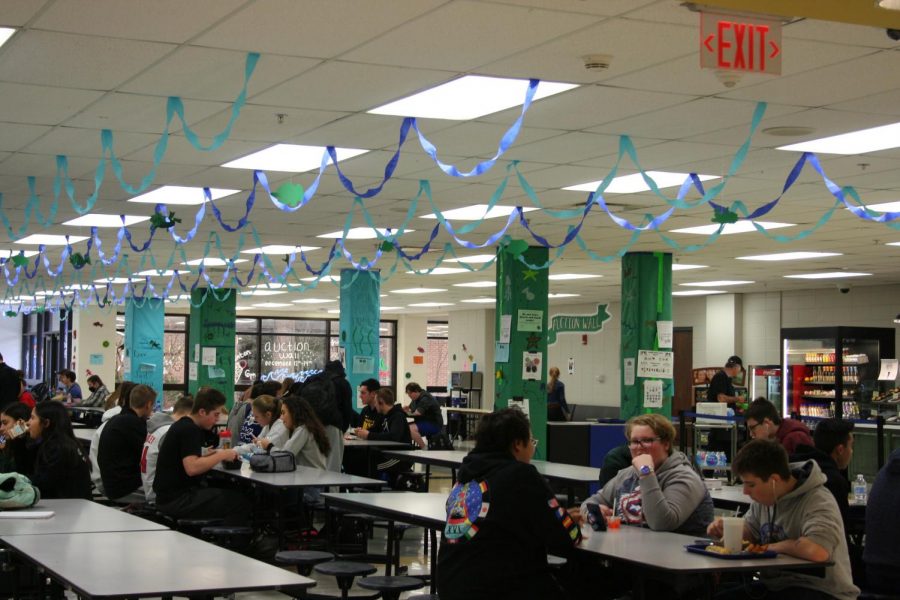Cafeterias, calories, and consumers
A look at how healthy the food sold at school is and how that impacts students
Photo by Photo by Marissa Drake
The cafeteria at school contains many different food options for students to choose from, some of which are healthy and some of which are not. However, according to Elizabeth Garcia, health teacher, it is up to the consumer to decide how healthy they would like to eat.
It’s that time of the year again, when holiday follows holiday follows holiday and cheer is in the air. But with the holiday festivities and cheat-days comes an underlying lurking presence: weight gain. According to an article by the New York Times, the average person gains 1-2 pounds between Thanksgiving and Christmas, and for high school students, this change can also be attributed to the health of the food at their schools.
“[LZ is] much lower than the national average for things like obesity and BMI measures but that isn’t a really good measure of our overall health,” Elizabeth Garcia, health teacher, said. “Nutrition, actually, is a major concern here because there’s a lot of refined foods, rather than fresh fruits and vegetable, being served here. It’s kind of the next public health crisis. Maybe not at our socioeconomic level, but overall, in our country, snacks and sodas have had a devastating impact on kids, to a certain degree.”
According to Garcia, this excess of refined foods, along with high-fat and sugary processed foods, is an issue in terms of the health of the students, because “they are not getting a lot of their vitamin and fiber needs met when they eat like that.”
However, Kathy Taylor, food service director for the school district, contends that many of the healthy options that the school serves are often overlooked by both students and teachers alike.
“We provide a lot more healthy options than people think we do,” Taylor said. “All of our items are baked; we don’t even have fryers here. We have plenty of healthy options, like build your own pizza [which is] a flatbread pizza and very low in fat and calories, [and we] have been doing a lot more fresh vegetable entrees too, so we have a wide array of healthy things. At our salad bar, you can easily make yourself a nice salad and even the deli bar has a ton of fresh vegetables. We use local vendors whenever we can and it’s all local vegetables and local milk, so not only are we trying to provide fresher and healthier stuff, but we’re also trying to be local.”
In addition to their current menu, Taylor says the food service staff at school is constantly working to make their food even healthier by introducing new concepts each month that are fresher and leaner.
But for some students, the problem of healthy and unhealthy food does not arise from what is being sold, but rather, from the prices.
All the food they do have that is healthy is really expensive,” Kayah Pura, senior, said. “I mean, getting a wrap is like four dollars, which is kind of a lot. If [the cafeteria] had more options that were more varied and cheaper, I’d definitely consider buying lunch there more often.”
But while Taylor says that she is always looking for student input and that the goal of the cafeteria is to provide the students with healthier options for lower prices, there is a limit on how low their prices can go.
“We try to keep it as reasonable as possible, we know kids are on a budget, but the food isn’t free to us either,” Taylor said. “We have to purchase the food, pay people to cook it, and then serve it. We are conscious of prices but we can’t give it away because it is a business, that money has to cover that, and I have that responsibility to the district. We’re not here to make tons of money, but we also can’t operate in the negative.”
Ultimately, however, despite any disagreements regarding the school food that there may be, both Garcia and Taylor agree on one thing: the consumer alone is responsible for their own healthiness and choices.
“Kids have to have choices so that they can learn from their decisions,” Garcia said, “so in the end, it has to be their choice on whether or not they want to become a customer to the sugar and fat industries.”

As a senior, Caroline's back for her third year as Digital EIC. If you ever catch her outside of school, she'll probably be running with the cross country...

